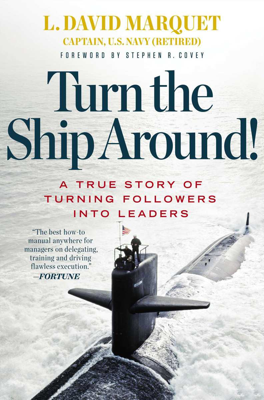Change, in a Word
Decision-Making Shift on USS Santa Fe
David Marquet interacts with the chiefs of the USS Santa Fe in a meeting designed to initiate a shift from the traditional leader-follower dynamic to a leader-leader model, aiming for a more decentralized decision-making system.
Analysis of Current Leadership
Marquet recognizes that the authority of chief petty officers had been eroded over time due to systemic and historical reasons, highlighting the need for enhanced operational responsibility among the chiefs. He observes that traditional naval practices emphasized the commanding officer's accountability at the expense of empowering chiefs.
Instituting Leader-Leader Principles
Marquet proposes introducing a bottom-up leadership philosophy, as opposed to top-down, and opts to start the change with the chiefs, a group he sees as strategically positioned to influence widespread changes but underutilized under current norms.
Strategic Meeting Initiatives
- Intimate Group Setting: Meeting with the chiefs in a less formal, historically significant setting to promote open discussion and earnest engagement.
- Direct Engagement and Questions: Marquet challenges the chiefs by questioning their real influence on the ship, uncovering a discrepancy between perceived authority and reality, and then invites them to consider what true responsibility would entail.
Implementations Proposed
- Modify Leave Approval Process: A key change proposed is to simplify the leave chit approval process by making the Chief of the Boat (COB) the final authority, reducing bureaucratic steps and empowering the chiefs.
- Holistic Authority Over Personnel Management: this includes managing watch bills and qualification schedules, aiming to give chiefs complete control over their division's schedules and responsibilities.
Challenges and Concerns
Concerns about the competence of the chiefs to handle new responsibilities and the trade-offs in officer training experiences are discussed. Marquet addresses these by adjusting regulations and trusting the chiefs to manage effectively, despite recognizing it as a move beyond his explicit authority.
Long-Term Institutional Change
Marquet aims to establish enduring organizational mechanisms rather than rely on temporary motivational initiatives, reflecting on insights from the book Built to Last about creating lasting institutional changes.
Mechanisms for Control
- Find the Genetic Code for Control and Rewrite It: Emphasizes incorporating simple but profound changes in organizational documents to redefine control and authority structures.
- Addressing Competence and Clarity: Prepares to support the chiefs by ensuring they possess not only the technical knowledge required but also a clear understanding of the ship's mission and goals.
Reflective Questions for Application
Marquet provides a guide for other leaders to evaluate and implement similar changes in their organizations, focusing on identifying and amending decision-making processes and enhancing mid-level managers' roles from mere privilege to active responsibility and accountability.
This transformative approach highlights the need for and methods toward shifting from a hierarchical to a distributive leadership model, empowering mid-level managers and enhancing overall organizational effectiveness.
